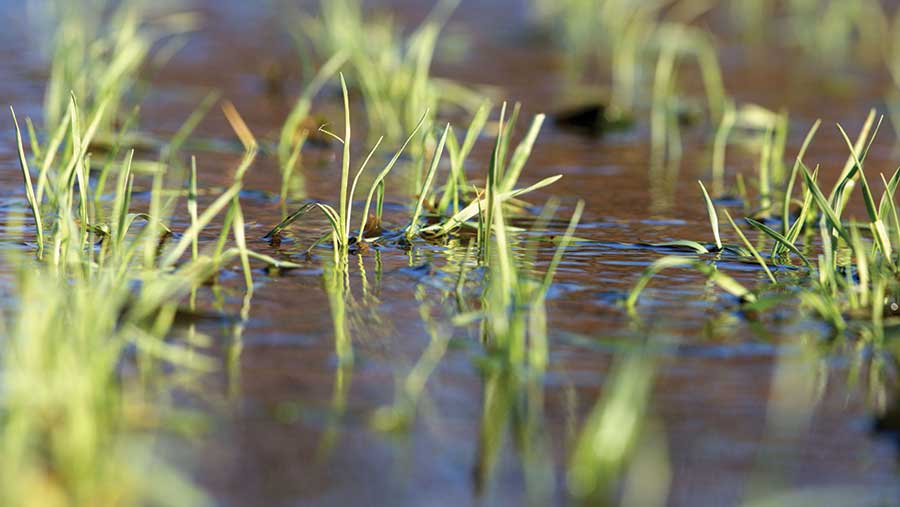Wet weather raises rooting worries for winter cereals
 © Tim Scrivener
© Tim Scrivener Winter cereal growers may need to use extra feeds and growth regulators to encourage rooting this spring to give high yields after a winter of waterlogged fields.
Heavy winter rains have resulted in sodden soils across many arable areas, making it difficult for plants to root. This is likely to limit their ability to pick up nutrients.
Edward Downing, nutrition expert at agronomy group Frontier, says water-soluble phosphate fertiliser, phosphite foliar feeds and plant growth regulators (PGRs) may be required to stimulate root growth.
“If I was worried about rooting, I would be looking at a combination of these things,” he tells Farmers Weekly.
The warm autumn has seen strong plant growth, but heavy rainfall has seen many crops struggle to root and create a firm foundation for future yields in saturated conditions.
“A little bit of nitrogen and a reasonable amount of water-soluble phosphates would help encourage rooting,” he adds.
See also: Swing to spring cropping after rapeseed area falls
Nitrogen applications could be tricky to calculate this spring, as a warm autumn will have encouraged more mineralisation of nitrogen from the soil, but the wet weather may have led to more leaching.
Daniel Kindred, senior research scientist at consultants Adas, says growers should be looking to test soils in February to try to work out their crops’ nutritional needs.
He points out that from Met Office data, the north of England and Scotland were very wet in November and December, while rainfall in south and eastern England was close to normal levels.
“Many crops are forward and lush, and so testing soils in February would be good advice to work out how much nitrogen has been mineralised and how much leached,” Dr Kindred says.
One result of poor rooting is a higher risk of root lodging, where plants move in the soil because of poor anchorage, and so can collapse and end up on the ground.
Jason Tatnell, technical manager at agrochemicals group Syngenta, says anecdotally most lodging seen in cereals is now root lodging, as there is much less stem lodging.
“For example, rooting may have stopped at an anaerobic layer in the soil,” he says.
Mr Tatnell believes lodging in cereals is more strongly linked to wet soils, and this can lead to poorer uptake of water and nutrients in the spring, leaving crops more vulnerable to drought.
He says there is still time to overcome this, as cereal crops produce new roots right up to the flag-leaf emergence stage, usually in May.
Trials in Germany showed the use of PGR Moddus (trinexapac-ethyl) + chlormequat at T1 timing led to a 11-12% rise in rooting mass, and other trials point to improved water use and uptake of nutrients, he adds.
When applying PGRs to regulate growth, Mr Tatnell says T1 is the optimum timing. However, for rooting he is seeing more reliable benefits when applied at the earlier T0 timing.
“This is because it allows more time for the benefit of rooting to be seen,” he says.

